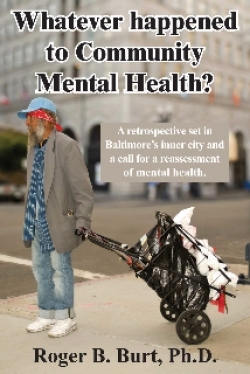Whatever Happened to Community Mental Health?
A Retrospective Set in Baltimore's Inner City and a Call for a Reassessment of Mental Health
- 2010 INDIES Finalist
- Finalist, Psychology (Adult Nonfiction)
Sometimes, the best way to plan for the future is to learn from the past. For those in the mental health profession, that thinking can be particularly useful, believes clinical psychologist Roger Burt. By presenting a look at Baltimore’s community mental health movement in the 1960s, he describes a groundbreaking initiative that still holds lessons for today, and even more importantly, for tomorrow.
Burt became part of the movement in the late 1960s, around the time that he was completing his Ph.D. work at Duke University. He joined a program administered by the University of Maryland, excited by the larger mission of serving those who were disenfranchised and impoverished.
Not long after, he became embroiled in the academic politics there, seeing the first real disconnect between on-the-ground community mental health workers and the institutions that supposedly aimed to support them. Despite those challenges, though, a true reform was beginning at the time, fueled by passionate clinicians and community organizers. “Such movements attract particular kinds of tenacious and dedicated people,” writes Burt. “And so we clung together, determined to build a system which would serve a seriously disadvantaged population.”
Of particular interest to those in the mental health profession, Burt gives comprehensive details about the type of therapeutic and service issues they encountered, and emphasizes that the community health model was only just being developed at that time. Classical psychotherapeutic intervention and psychoanalysis was still in vogue to some degree, and to create a more workable program, those in community mental health had to design new forms of services, especially around creating more trust between clinicians and their clients.
Burt also includes the type of challenges faced by staff members and professionals, including feelings of personal inadequacy, over-identification with clients, and “liberal guilt.” In looking back, Burt notes, “Community mental health was a bold experiment that in all likelihood was doomed to fail from the beginning.” But he doesn’t believe that it was a waste of time, especially as a new reform movement in healthcare and mental health seems to be just beginning. He asks, “Could we be looking at an opportunity for a new chapter in the delivery of mental health services?”
The level of examination Burt provides in the Baltimore example of community mental health should be a boon to any psychologist, therapist, or administrator who’s looking for fresh ideas about mental health delivery. This is a call for mental health professionals to take a new look at the past, and mine it for future possibilities.
Reviewed by
Elizabeth Millard
Disclosure: This article is not an endorsement, but a review. The publisher of this book provided free copies of the book and paid a small fee to have their book reviewed by a professional reviewer. Foreword Reviews and Clarion Reviews make no guarantee that the publisher will receive a positive review. Foreword Magazine, Inc. is disclosing this in accordance with the Federal Trade Commission’s 16 CFR, Part 255.

